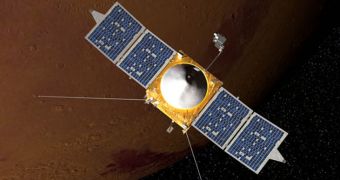Officials at the American space agency decided on October 4 to green-light a new phase of the Mars Atmosphere and Volatile Evolution (MAVEN) mission, the next NASA orbiter to the Red Planet.
With the new approval for development, the spacecraft will begin to be built, and will be readied for a 2013 launch date. This approval was a critical milestone for the new mission.
The main goal of the investigations that MAVEN will be conducting is to determine how is it that Mars manage to lose most of its atmosphere. The Red Planet has been keeping this mystery for years.
Thanks to advanced surveys of our neighboring planet, we now know that an ocean of liquid water, and numerous rivers may have existed there in the past couple of billion years.
Images collected by the HiRISE instrument on the Mars Reconnaissance Orbiter (MRO) have revealed the existence of what appear to be dry riverbeds and deltas on the planet.
The rovers Spirit and Opportunity have found minerals that could have only formed in the presence of water, and the Phoenix Mars Lander detected water ice near the North Pole.
Experts now believe that, at one point, a massive climate change occurred on the planet, that saw most of the atmosphere surrounding the cosmic body being lost.
This is where MAVEN comes in. Its suite of scientific instruments will be perfectly calibrated to conduct measurements of the atmosphere, and to determine the cause of the ancient loss.
“A better understanding of the upper atmosphere and the role that escape to space has played is required to plug a major hole in our understanding of Mars,” explains Dr. Bruce Jakosky.
“We’re really excited about having the opportunity to address these fundamental science questions,” adds the expert, who is the principal investigator of the MAVEN mission.
Jakosky holds an appointment in the Laboratory for Atmospheric and Space Physics (LASP), at the University of Colorado in Boulder (UCB).
“The team has successfully met every major milestone since selection two years ago,” adds the MAVEN project manager, David Mitchell.
“Looking forward, we are well positioned for the next push to critical design review in July 2011. In three short years, we’ll be heading to Mars!” concludes Mitchell, who is based at the NASA Goddard Space Flight Center, in Greenbelt, Maryland.
The Jet Propulsion Laboratory (JPL) will also be involved in the project, by supplying navigation support, the Deep Space Network, and the Electra telecommunications relay hardware and operations.

 14 DAY TRIAL //
14 DAY TRIAL //